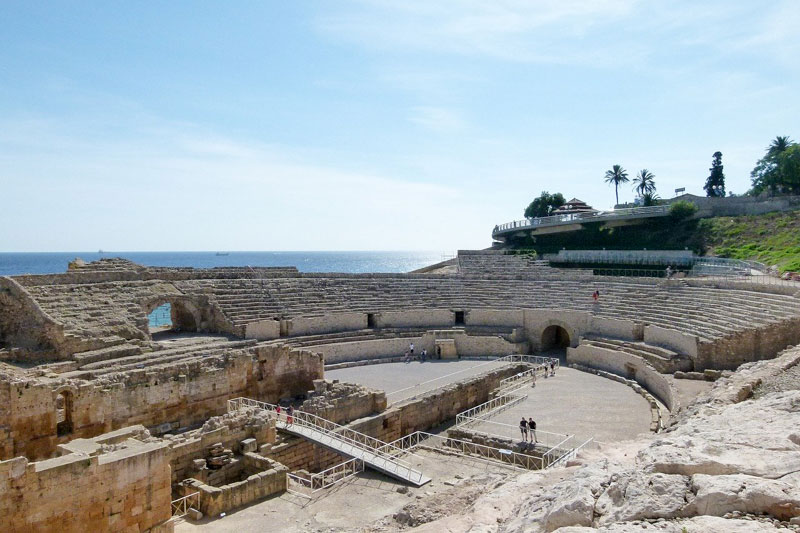Best Places to Visit in Spain this Autumn
The Spanish once dominated the New World through conquistas but when you come to think of it, they had no real reason to leave their beautiful land. From the coastline and cities such as Valencia and Barcelona, all the way to the bustling capital of Madrid, you will never get bored in Spain.
Admittedly, summer can get quite hot in most regions of Spain. This might be a good thing if you’re going for a summer holiday on the Balearic Island but autumn is more soothing for guests arriving from abroad. This is the time colors are the most beautiful in Span, when harvest season arrives, and when the streets of major cities are no longer crowded with tourists.
What is more, September and October usher in a literal breeze that can be pleasant in combination with a warm climate. In an autumnal climate like that, you can spend hours outside, enjoying the landscape. Autumn is the ideal time during the year to visit the country’s capital of Madrid, as it is unbearable to stay there during the summer heat.
Useful resources for your journey to Italy in fall:
- Amazing Travel Hacks You Want to Know Before Your Next Trip
- Experts Advise: The Best Travel Accessories and Gadgets
- Best Car Accessories and Gadgets for Your Road Trip
Cadiz

One of my favorite cities to visit in autumn in Cadiz in Southern Spain. Why? There are plenty of reasons! First, let’s mention the warm temperatures. Indeed, in Cadiz, you can still enjoy above 20°C until mid-November.
Then, let me mention the breathtaking architecture of Cadiz. Considered once the most important town in Southern Spain, Cadiz boasts gorgeous plazas and colonial architecture.
Some of the best things to do in Cadiz in autumn include climbing up the cathedral tower to enjoy the best view of the city. The next stop would be the theatre Manuel de Falla which is one of the prettiest in Southern Spain. From here, make your way to Plaza de San Juan de Dios to enjoy a coffee.
At night, you can’t leave without enjoying the famous shrimp fritters from Cadiz.
Suggested by Paulina, Paulina on the road
Madrid

Are you looking for a city trip in autumn? However, you are not much a fan of cold temperatures? Then, let me take you to Madrid! The Spanish capital boasts still warm temperatures until October and it’s one of the most lively towns in Europe.
Even if you have only 24 hours in Madrid, there are plenty of things to see in the capital of Spain. Start your day in Plaza Puerta del Sol and take a picture at KM 0. From here walk to Plaza Mayor, once the most important central square in Spain. It’s the perfect place to enjoy a café con leche with some churros.
From here, continue your walk to the Royal Palace and the Debod Temple. Make sure to include some time to rest and enjoy the gorgeous views above Casa de Campo forest.
By night, I highly recommend enjoying tapas in La Latina district and watch a flamenco show in the best tablao in town: Casa Patas.
Suggested by Paulina, Paulina on the road
Barcelona

This autumn, you must take out a weekend to visit Barcelona.
With an incredible sense of European culture and home to the famous Las Ramblas, you definitely do not want to miss out on this city. On arrival, it is pretty simple to grab a sim card from the airport, and getting around is easy on the underground subway network. We used buses quite regularly too get around the city and felt safe everywhere we went.
Amongst the wonderful places to see, be sure to start with a trip to the Sagrada Familia. Built-in 1882, you will get an amazing view of the city from the top. You will most certainly enjoy walking up and down Las Ramblas, a hot spot for tourists with lots of different shops, stretching about 1km. Make sure you grab a fresh orange juice from one of the many famous stalls. There is something special about the local oranges!
Moving away from the hustle and bustle of Las Ramblas, our recommendation would be to visit the Park Guell. In 1984 it was declared a World Heritage Site and was originally designed to represent English cities that were planned to have greenery amongst the town. It is a beautiful green space in Barcelona and one not to miss seeing.
Suggested by Manpreet, HelloManpreet.com
Mataró

If you’re near Barcelona, then you absolutely should spend a day in Mataró, a beautiful coastal town with a history dating back to the Romans. Though you could easily spend more than a day here, I think a day is the perfect amount of time to spend in this town. It’s easily reached by Barcelona’s public transport system and it’s filled with so many great things to do. Plus, Mataró is a lot less busy than Barcelona, but is still right on the coast!
My top recommendation for this beautiful town is to go to Playa Del Varador, a beautiful beach that’s a lot less busy than La Barceloneta. There’s a beautiful promenade you can walk along and grab some snacks, and the sand is really soft. There’s also other more popular beaches in this town, like Platja de Sant Simó and Playa del Callao, which are also worth visiting if you have the time. You could easily spend your day beach-hopping!
I also recommend you visit Xurreria Rosita, a very affordable little restaurant to grab Churros con Chocolate. There are so many different sizes and types of churros here, so you’re bound to find one that you’d want to try! While you’re in the area, be sure to also explore the beautiful downtown, and also take a walk to Central Park. Trust me, Mataró is one underrated town in Spain you won’t want to miss.
Suggested by Krystianna, Volumes & Voyages
Malaga

The southern region of Spain became a popular destination only a few years ago but it welcomes more and more tourists every year. And why wouldn’t it? From socializing at night in one of the rooftop cocktail bars in the city center to relaxing in beachfront chiringuitos in El Palo, there are plenty of ways to spend time in Malaga.
I hung out the whole month of October in Malaga last year and didn’t wanna leave when the time came. Absolutely perfect weather to still wear light dresses and shorts and even swim, delicious food choices, easy commuting options even in the nighttime, lots of historical sites and hiking opportunities… and don’t even get me started on their helado!
Whether you have just a weekend or a full month to travel, I can’t recommend Malaga enough. This is the place you never get bored at! The most iconic spots to visit include Muelle Uno, a beautiful waterfront shopping promenade, Alcazaba fortress, and the lovely gardens of Parque de Málaga.
Besides the wonderful variety of experience in the city itself, there are plenty of day trip opportunities you can consider. Hiking in Caminito del Rey, attending a street festival in Fuengirola, walking around patios filled with flowers in Cordoba, and so many more cool activities available by short train or bus ride. Not to shock you, but you can literally hop on a ferry and be in Africa in half an hour, how cool is that!
Suggested by Juliet, Live Your Dream TODAY
Nerja

When you run out of ideas on what to do in Malaga, it’s time to explore the neighboring towns and villages! There are plenty of opportunities for one-day trips from Malaga as it’s the heart of Andalusia and the central hub for all the local connections. The one destination worth mentioning in particular is called Nerja.
Located to the very right edge of Malaga, Nerja is basically the eastern end of the Costa del Sol region that is of interest to tourists. It’s easily accessible by bus and can be visited on any day according to a well-defined bus schedule.
Small as it is, in recent years it’s become a popular tourist destination, although most people overlook it when they visit Spain. Famous by its various magnificent beaches and Balcon de Europa, the viewpoint from which you can see Africa on a good day, Nerja is a not-so-hidden gem.
It only takes about an hour to get to Nerja from the central bus station in Malaga. One day is quite enough to walk around the whole town, but if you stay for a couple more days, you can also see the Eagle Bridge, visit the incredible cave complex, and get to the less crowded beaches on the outskirts. I’d recommend visiting Nerja around October when the water is still pleasant to swim, but there aren’t so many tourists compared to summer.
Suggested by Juliet Dreamhunter
The Basque Country

This is an amazing region in the north of Spain. It’s famous for the spectacular coastal scenery, pristine beaches, unique culture, and one of the best cuisines in the world. The Basque Country is a great place for outdoor and adventure lovers. There are many hiking and cycling routes here including the Camino del Norte, a long-distance route across Northern Spain.
Visiting the region in autumn has several advantages. It’s less crowded than during summer
when thousands of tourists come here for a summer beach holiday. Due to the lower demand, accommodation prices decrease significantly. The weather is still great, it’s not too hot like in July and August which is great for practicing outdoor sports such as hiking, cycling or mountain biking. Autumn is the harvest season and local markets are filled with fresh vegetables and fruit. You can pick walnuts, chestnuts and berries hiking in the forest or walking in the park.
The best way to explore the Basque Country is to rent a car and drive along the coast for a week or two depending on how much time one has. Start a trip to San Sebastian, one of the most beautiful Spanish cities with perfect beaches, delicious food, and vibrant nightlife.
Continue along the coast past small beach towns of Zarautz and Getaria. Zarautz is a great place to learn surfing. Drive along the coast for a week till you reach Bilbao, one of the most interesting and dynamic cities in the region.
Suggested by Alya & Campbell, Stingy Nomads
Tarragona

Tarragona is a Roman port city located in northeastern Spain’s Catalonia region on the Costa Daurada. Generally, you won’t find this place in an ideal Europe itinerary, but it is definitely worth a visit. It is situated at a distance of 92 km south-west from Barcelona city center. Hence, it is culturally similar to Barcelona but thankfully has much lesser crowds than Barcelona.
Tarragona is a great place to visit because it has an interesting combination of well-preserved Roman ruins of an old historic city, stunning beaches, dynamic port, lovely museums, and a vibrant city center.
The best things to do and see in Tarragona are Tarragona Amphitheatre, Miracle Beach (Platja del Miracle), Tarragona Cathedral, Les Ferreres Aqueduct (Pont del diable), National Archaeological Museum, Paleochristian Museum and Necropolis (Museu i Necròpolis Paleocristians) and the beautiful beaches along the Costa Daurada.
You can find some of the best fresh seafood in Tarragona as it is a Mediterranean port. The place also has an amazing range of signature wines. Be it cultural richness or the warmth of the local people, the city has a unique charm that wins you over.
You need two days to explore the best of Tarragona. If you’re planning on staying in Tarragona, then book your accommodation near the Rambla Nova city center as it provides easy access to all parts of the city.
The easiest way to get to Tarragona from Barcelona is by train. You can board a train from any of these three stations in Barcelona – Passeig de Gràcia (1 hr 15 min), Estació de França (1 hr 27 min), or Sants (1 hr 10 min). A one-way train ticket costs anywhere between 8-10 euros. Check the train schedules and book your train tickets either on Renfe or Rail Europe
Suggested by Vaibhav Mehta, The Wandering Vegetable
Palma de Mallorca

Palma de Mallorca, also known as the “Pearl of the Mediterranean”, is the capital and largest city of the self-governing community of the Balearic Islands in Spain. It is one of the European destinations with rich cultural heritage and contemporary flair that’s hard to ignore.
Located on the west coast of Mallorca, Palma is a perfect holiday destination for people who seek a mix of history, nature, food, and culture. From impressive Gothic architecture in historical buildings and old town charm of aristocratic townhouses to the cool pavement cafes, and stylish modern-day museums, Palma has something to offer to every kind of traveler.
The best things to do in Palma de Mallorca are Cathedral of Santa Maria of Palma (La Seu), Plaza Mayor, sightseeing tour of Soller with a boat ride and vintage Train journey, Soller Bellver Castle (Castell de Bellver), Palma Aquarium, a boat cruise to the east coast of Mallorca, Palma City Beach (Can Pere Antoni), Royal Palace of La Almudaina, a day trip to Majorica Pearl Shop and Caves of Drach, Es Baluard Museum of Modern and Contemporary Art, and shopping at Passeig del Born.
Besides these things, you can do a cycling tour around Palma, enjoy bar hopping in the Santa Catalina neighborhood, taste authentic Balearic Cuisine at Mercat de Santa Catalina and dine at Michelin star restaurants (Zaranda, Adrián Quetglas, Marc Fosh).
I recommend you spend at least 4 days to explore the best things that Palma de Mallorca has to offer. But if time isn’t a constraint, then a week is an ideal duration.
The lifestyle of Palma is liberating and addictive. You can meander around the streets, visit museums and historical sites during the day and let your hair down at an uber-cool party place at night. If there’s a place in Europe that truly encapsulates the feeling of wanderlust, it is Palma de Mallorca.
Suggested by Vaibhav Mehta, The Wandering Vegetable
Seville

Traveling in autumn doesn’t always guarantee the best weather, but one city in Europe is still warm like summer during that time; it’s Seville, Spain! Seville is actually the sunniest city in Europe, and aside from great weather, there are also fewer crowds there in autumn compared to the peak season of spring. Seville is also the birthplace of tapas and flamenco, so if you’re up for a delicious, cultural, and historical destination, then this is the perfect place to visit.
I recommend spending at least 3 days in Seville to take in all that it has to offer. Some of the key things to do here are: walk around the beautiful Plaza de España, visit the historical Alcázar, admire the azulejos (traditional ceramic tiles) of Casa de Pilatos, explore Seville Cathedral and its Giralda tower, watch a flamenco show, and most important of all — have as much tapas as possible! The traditional tapas you’ll find here are absolutely remarkable, and two of the best restaurants to try them in are Espacio Eslava and El Rinconcillo.
Another great thing about Seville is that it’s a very walkable city, and there are lots of charming, colorful neighborhoods around. Definitely take a stroll in Barrio Santa Cruz and Triana, and remember — sometimes, you find the coolest places by getting lost!
Suggested by Jiayi Wang, The diary of a nomad
Valencia

Valencia is well on its way to beating Madrid and Barcelona in becoming Spain’s most popular city. And rightfully so. Even though Valencia has a magical medieval city center, the city has never been afraid to innovate. At the beginning of the last century, the city council decided to drain the river Turia, which was forever flooding Valencia and turning it into a grand city park stretching from the outskirts of Valencia all the way to the sea. One of the most striking sights in the park is the cutting-edge buildings of Ciudad de las Artes y las Ciencias designed and built by Valencia-born architect Santiago Calatrava. And if you walk past Valencia’s Modernist train station Estacion del Norte you’ll discover a grand neighborhood filled with the most amazing Modernist buildings, with the Mercado de Colon as the perfect center point to sit down and enjoy a drink.
I fell completely in love with Valencia because of its extreme diversity. The cutting edge street art that fills the walls of Barrio del Carmen, the dazzling nightlife of the Ruzafa neighborhood, and the quaint charm of seaside quarter El Cabanyal which reminded me of Cuba. To experience Valencia at its fullest, the best thing to do is to rent a bicycle for a couple of days so you can explore beyond the city center and marvel at the brilliant architecture, enjoy paella at the beach, and relax in the nearby La Albufera lagoon.
Suggested by Esther de Beer, mooistestedentrips.nl
Granada

If what you seek is a little Spanish flair in your travels, with just a touch of historical and architectural significance, I urge you to check out Granada! This stunning Andalucian city truly has all of that and more.
The main attraction in Granada, one that draws millions of visitors each year, is the Alhambra. The Alhambra, its Nasrid Palaces, and stunning gardens are a sight to behold. Named for the red coloration of its exterior walls, the complex dates back to the 9th century and has housed Kings of Granada through the ages. The intricate carvings in the walls of the Nasrid Palaces are mind-boggling. The beauty of Generalife gardens is hard to comprehend. Be sure to book your tickets in advance, as they will sell out long before the day of your tour.
After spending time in the Alhambra, I recommend a tour through the white-washed corridors of the Albaicin, Granada’s most charming neighborhood. Have a snack on a patio, then search for lookouts where you can view the Alhambra from afar.
If you are looking for additional details on Granada and the Alhambra, check out my full post on spending a day in Granada, Spain.
Suggested by Hillary Newman, Hillarynewmanphoto
Tenerife

Tenerife is one of the most exotic parts of Spain and is a popular destination for weekly winter sun holidays, with excellent flight connections and plenty of accommodation choices. There are several stunning beaches for relaxing and enjoying picnics, but there’s so much more to Tenerife if you head inland. Don’t miss Teide National Park with its volcanic landscapes, sweeping panoramas, and winding roads.
One of the best things to do in Tenerife is descended Mount Teide in a cable car and check out the three hiking trails at the top, just make sure you take plenty of water as it gets very hot up there. Another popular spot is Masca, a delightful village perched precariously on a ridge in the Macizo de Teno Mountains.
Hire a car and brave the hairpins before rewarding yourself with an ice-cream and a view. There are several hiking trails in the area too if you’re feeling energetic. Back at the beach, daily boat trips take visitors whale and dolphin watching, and some offer a buffet lunch as well as snorkeling.
For families, Siam Park in Costa Adeje is one of the most impressive water parks in all of Europe and the perfect place to cool off on a hot day. Finally, take some time to wander the sleepy streets of Garachico, a charming town on the unspoiled northern coast. Here you’ll find sea pools to swim in amongst the volcanic rock, traditional old churches, leafy squares, and even a castle.
Suggested by Heather Cole, Conversant Traveller
Segovia

Love walled cities, fairy-tale castles, or ancient Roman ruins? then 100% you will adore the UNESCO Heritage-listed city of Segovia. Segovia is located about 100km north of Madrid with easy access via road or train.
Segovia gained its UNESCO status in 1985. There are several points of interest here but the biggest and most iconic one is the El Aqueducto, or the Aqueduct of Segovia. This is also the symbol of the city, which you’ll see dotted all over the place. I always find it astonishing that the 160 arched structure was built with no mortar, gravity is doing its wonderful thing, but, and I love this fact, it STILL works to this day and even after all these hundreds of years, delivering fresh water to the city!
There are a few stories about how the aqueduct got here, some say that it was built by Hercules whereas other stories will tell you that it was built by the Devil. Both make for fascinating and enchanting legends, but in actual fact, how it got here is far less fantastical. It was built by the Romans at about 1st Century AD.
In Segovia, it’s also worth spending some time at Alcazar of Segovia, which is said to have inspired Walt Disney’s castle, the Magic Kingdom. You can walk around the grounds as well as go inside. Other things well worth seeing are Segovia Cathedral and walking along a few of the remaining segments of the Old City walls. It’s a perfect city to explore by foot, and part of the fun is getting lost in the labyrinth of pretty cobbled streets and picturesque squares.
Suggested by Becki, Meet Me In Departures
Santander

Santander on the North coast of Spain is a great place to visit. The food is fantastic and they have some of the best city beaches in the country, with Playa del Sardinero and Playa de Somo great spots for surfing. The most popular attraction in Santander is Magdalena Palace, the former summer home of the Spanish Royal Family. The palace is located on a peninsula with breath-taking views across the Bay of Santander towards the mountains in the distance. Walking around Santander you’ll find some amazing street art by talented artists including local creator Okuda San Miguel. A man was well-known for his unique style.
Santander is a somewhat hilly city but in compensation, they have outdoor escalators and a funicular. A ride up on the funicular takes you to an observation deck overlooking the city. Not only an incredible viewpoint but also allowing you to get your bearings. Following the coast from the city center leads along two beautiful coastal paths. One to Magdalena Palace and another out to the lighthouse at Cabo Mayor.
At least two days is recommended to truly get the best out of Santander and longer if you plan on exploring any of the stunning surrounding Cantabria landscape. Picturesque villages such as Santillana del Mar and Comillas are less than an hour away. A little further is Potes, high up in the spectacular Picos de Europa mountain range.
Suggested by Stuart Fahy, Just Travelling Through.
Santiago de Compostela

After walking the Camino back in 2018, the final destination at the end of the epic journey was, of course, Santiago de Compostela. Namely, the famous cathedral there which is the reputed burial place of St James the Great, the apostle to Jesus Christ. Before arriving, I really didn’t know what to expect as this city had never been on my radar as a major place to visit.
But in the end, I quickly fell in love with the city! So much so that I spent 3 nights here celebrating the completion of my epic walk and enjoying the many sites the city has to offer. Besides the grandiose cathedral, which is definitely one of the best spots, you have other major buildings like the Monastery of San Martiño Pinario, Museo del Pueblo Gallego, and the Convent of San Domingos de Bonaval.
I recommend taking plenty of time to simply get lost walking in the maze of cobbled streets. Quaint bars, restaurants, and cafes line the streets of the city which are always alive with excitement and atmosphere. Particularly at night time when street performers come out. My favorite nighttime spot was the main plaza outside the cathedral.
Here, under one of the arches, we found an opera singer making use of the natural acoustics offered by the surrounding walls. You’ll also find hundreds of small shops selling local artisan goods and wares. I recommend spending at least 3 nights here, making it the perfect spot for a city break.
Suggested by Bradley, Dream Big, Travel Far
Alicante

One of the best places in Spain is Costa Blanca’s capital Alicante, a peaceful coastal city that offers various attractions. With a rich history, colorful streets, beautiful sandy beaches, and 3,000 hours of sun per year make it one of the popular vacation destinations for locals and foreigners.
The main attraction in Alicante is the hilltop Castle of Santa Barbara overlooking the Mediterranean and the city itself. The castle is considered to be one of the biggest medieval fortifications in Spain dating back to the 9th century when Muslims controlled the Iberian Peninsula.
The path to the castle passes through a charming Santa Cruz district starring white-colored houses beautified with bright and colorful doors, windows, flowers, and balconies.
Additionally, Alicante is home to numerous impressive cathedrals and churches such as Valencian Gothic-style Basilica of St. Maria or the Co-Cathedral of St. Nicolas, a Roman Catholic cathedral. The list of things to do in Alicante also includes a good selection of art galleries and history museums to satisfy the interest to learn more about the city.
Another great reason to visit Alicante is its location that enables travelers to explore neighboring towns like Benidorm, Javea, Altea, Villajoyosa, and Torrevieja’s pink lake.
Suggested by Baia Dzagnidze, Redfedoradiary
Gijón

Gijon, located in the northern region of Asturias, is definitely an up and coming city. Although popular with Spaniards, the city remains mostly unknown to foreign tourists. But Gijon is definitely not to be missed. There are so many things to do in Gijón, whether you love the culture, food, beaches, or the outdoors, there is something for you.
One of the best reasons to visit in autumn is that it will still be perfect beach weather. There are several beautiful beaches in Gijón, such as Playa de San Lorenzo, and quite a few hidden ones in surrounding areas. When the weather is clear, you can walk along the coast to check out some of the monuments, or head to Elogio del Horizonte in Cimavilla for beautiful views.
Autumn is also still a great time to visit for hiking. As the Asturias region is a popular spot along the Camino, there are plenty of hiking opportunities nearby, and paths are well marked.
If you’re not interested in the outdoors, there are also several fascinating museums in Gijón. Learn more about the local culture at the Museum of the Asturian People (includes the International Bagpipe Museum), or explore Roman ruins at the Roman baths. Gijón also has many wonderful cafes, Sidrerías, and vegan restaurants.
Suggested by Dagney, Cultura Obscura
Cordoba

Cordoba is a perfect introduction to the multicultural Andalucia in Southern Spain. It has flavors of the historical and cultural evolution of Andalucia. Be it the Roman times, the Moorish empire, or the Reconquista, every important transition in history has left its mark on Spain.
I highly recommend visiting the Mezquita-Cathedral of Cordoba that inherits this cultural amalgamation. Once a holy site from Roman times, this cathedral was then converted to a mosque during the Moorish empire. The design and styling details of Moorish architectures can still be seen here. During Reconquista, the mosque was then transformed into the Cathedral, with minarets being the bell tower of the cathedral. This makes it one of the most uniques architectures in itself.
Another highlight of the beautiful town is the Alcázar of Córdoba. This fortress served as one of the primary residences of Isabella I of Castile and Ferdinand II of Aragon. The gardens are really beautiful and definitely worth visiting.
One thing you will find very specific to Cordoba will be the beautiful flower pots lined streets. The white walls in this Andalusian city are decorated with colorful flower pots, which makes it a riot of colors and a perfect Instagram opportunity.
Cordoba can be explored in either a day trip from Seville or spending a night in between as well.
Suggested by Nisha, Nerdy Footsteps
Tarifa

Tarifa is one of the best places to visit in Spain, by water sports lovers. With sandy beaches that stretch for tens of kilometers and windy year-round, Tarifa has become the water sports capital of Spain. The quaint small town is home to more than 60 different kite surfing schools.
One of the best things to do in Tarifa is to learn how to wind or kitesurf. The schools have many different types of offers, from a two-hour introduction to kitesurfing lesson, to five days long camps.
Even if you are not a water sports enthusiast, you can still admire the professionals doing their tricks on the water.
There are plenty of other things to do in Tarifa for visitors who are not interested in water sports. The beaches are more than inviting, and some of the best in Southern Spain, equipped with all the facilities including lifeguards during the high season. One of the walks that everyone should do when visiting Tarifa is on the pier that divides the Mediterranean Sea from the Atlantic Ocean. At the end of it, you will find continental Europe’s most Southern point: Isla de las Palomas. Currently closed to the public, it can be visited from time to time on a tour organized by the Estrecho National Park.
Tarifa is a small town, with a lovely historic center. You won’t find any big shop or hotel chains here, most of the tourist businesses, hotels and restaurants being family-run.
Suggested by Joanna, Theworldinmypocket



